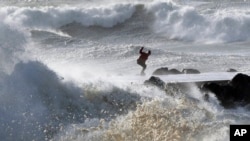Amidst all of the pomp and circumstance preceding last week's presidential inauguration, the National Oceanic and Atmospheric Administration (NOAA) released a far-reaching and detailed look at how climate change could affect America's and the world's coastlines.
The report lays out six different scenarios on how high sea levels can be expected to rise. The estimates range from 'low' to 'extreme' and in the extreme scenario could be expected to rise nearly 2.5 meters by the year 2100.
The effects of rising sea levels
The report is titled "Global and regional sea level rise scenarios for the United States" and it is an update on the kinds of information NOAA has been compiling and releasing for years. The most recent in 2012 laid out a potential sea level rise of about 2 meters. This new report revises that extreme scenario upward to a potential sea level rise of 2.5 meters in some places.
But “the ocean is not rising like water would in a bathtub,” says NOAA's William Sweet, the lead author. For instance, sea level rise along coasts of the U.S. Northeast and the western Gulf of Mexico is likely to be higher than average, and lower than average along the Pacific Northwest and Alaska coasts.
So the report drilled down to give local, regional and federal agencies, what Sweet calls "a systematic assessment along the entire U.S. coastline of how local sea level will likely change with certain amounts of global sea level rise."
That means information on patches of coastline as small as "roughly 70 miles" (112 km).
The idea was to let "a coastal manager in Miami and one in Mobile, Alabama," gauge the chances that sea level rise will affect their community, and then to prepare accordingly.
The report also lays out how this sea level rise will impact inland communities over the same time period, predicting that even a modest sea level rise on the 'low' scale of less than .3 meters could "raise the annual frequencies of... disruptive/damaging flooding" by 25 percent.
Sweet went out of his way to point out that these numbers aren't predictions, or projections, but simply different scenarios, and each one comes with what he calls a "probabilistic underpinning," based on different futures where humans either continue to pump the same amount, more, or less carbon into the atmosphere.
Predicting the cost
NOAA does these reports and provides them to other governmental agencies in order to better prepare other agencies responsible for protecting the increasing number of people living on the U.S. coastline. "Rising seas will dramatically increase the vulnerability of this growing population," the report says, "along with critical infrastructure related to transportation, energy, trade, military readiness, and coastal ecosystems and the supporting services they provide."
"Global mean sea level (GMSL)" according to the report, "has increased by about 21 centimeters (cm) to 24 cm since 1880, with about 8 cm occurring since 1993." Sea level rise, it says, "is a certain impact of climate change; the questions are when, and how much, rather than if."
The consequences, according to the report, will be higher storm surges, higher tides and stronger waves. "Even the relatively small increases in sea level over the last several decades have led to greater storm impacts at many places along the U.S. coast. At some locations in the United States, the frequency of tidal flooding (events typically without a local storm present) has increased by an order of magnitude over the past several decades, turning it from a rare event into a recurrent and disruptive problem..."
Revising estimates upward, says NOAA, is due to a better understanding of the instability of the ice sheets in Antarctica. And as we get better and better at understanding the climate, these numbers will continue to change.
The report does make one interesting notation -- all of the projections "discussed in this report recognize the inherent dependency (conditionality) of future GMSL rise on future greenhouse-gas emissions and associated ocean-atmosphere warming."
Which raises the obvious question: If we can control our greenhouse gas emissions, can we reverse this trend?
Sweet says that is one scenario that his team envisaged -- a future where we meet the aggressive climate agenda of keeping the average temperature rise around the globe to 2 degrees Celsius. Even in that rosy scenario, the study envisions a possibility that mean sea level rise will be anywhere between .2 and .5 meters.








